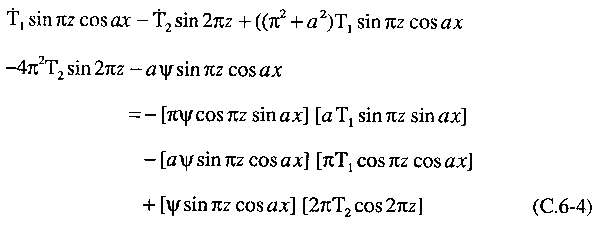|
C.6 Final
Form of the Lorenz Equations
Versão
em Português
We now substitute
the assumed forms for the streamfunction and the temperature
deviation function into Eqs. (C.4-2) and (C.4-5). As we do
so, we find that most terms simplify. For example, we have
The net result
is that some of the complicated expressions that arise from
 .grad
v terms disappear, and we are left with .grad
v terms disappear, and we are left with
The only way
the previous equation can hold for all values of x and
z is for the coefficients of the sine terms to satisfy
The temperature
deviation equation is a bit more complicated. It takes the
form
We first collect
all those terms which involve sin πz cos ax.
We note that the last of these terms in Eq. (C.6-4) is
2aπψT2 sin πz cos ax
cos 2πz. Using standard trigonometric identities,
this term can be written as the following combination of sines
and cosines: (-1/2 sin πz+1/2sin 3πz)
cos ax. The sin 3πz term has a spatial
dependence more rapid than allowed by our ansatz; so,
we drop that term. We may then equate the coefficients of
the terms in Eq. (C.6-4) involving sin πz cos
ax to obtain
All the other
terms in the temperature deviation equation are multiplied
by sin 2πz factors. Again, equating
the coefficients, we find
To arrive at
the standard form of the Lorenz equations, we now make a few
straightforward change of variables. First, we once again
change the time variable by introducing a new variable
t´´ = (π2 + a2)t'.
We then make the following substitutions:
where r is
the so-called reduced Rayleigh number:
We also introduce
a new parameter b defined as
With all these
substitutions and with the replacement of σ with p
for the Prandtl number, we finally arrive at the standard
form of the Lorenz equations:
At this point
we should pause to note one important aspect of the relationship
between the Lorenz model and the reality of fluid flow. The
truncation of the sine-cosine expansion means that the Lorenz
model allows for only one spatial mode in the x direction
with "wavelength" 2π/a. If the actual
fluid motion takes on more complex spatial structure, as it
will if the temperature difference between top and bottom
plates becomes too large, then the Lorenz equations no longer
provide a useful model of the dynamics.
Let us also
take note of where nonlinearity enters the Lorenz model. We
see from Eq. (C.6-10) that the product terms XZ and XY
are the only nonlinear terms. These express a coupling
between the fluid motion (represented by X, proportional to
the streamfunction) and the temperature deviation (represented
by Y and Z, proportional to T1 and T2,
respectively. The Lorenz model does not inc1ude, because of
the choice of spatial mode functions, the usual  .grad
v nonlinearity from the Navier-Stokes equation. .grad
v nonlinearity from the Navier-Stokes equation.
|








